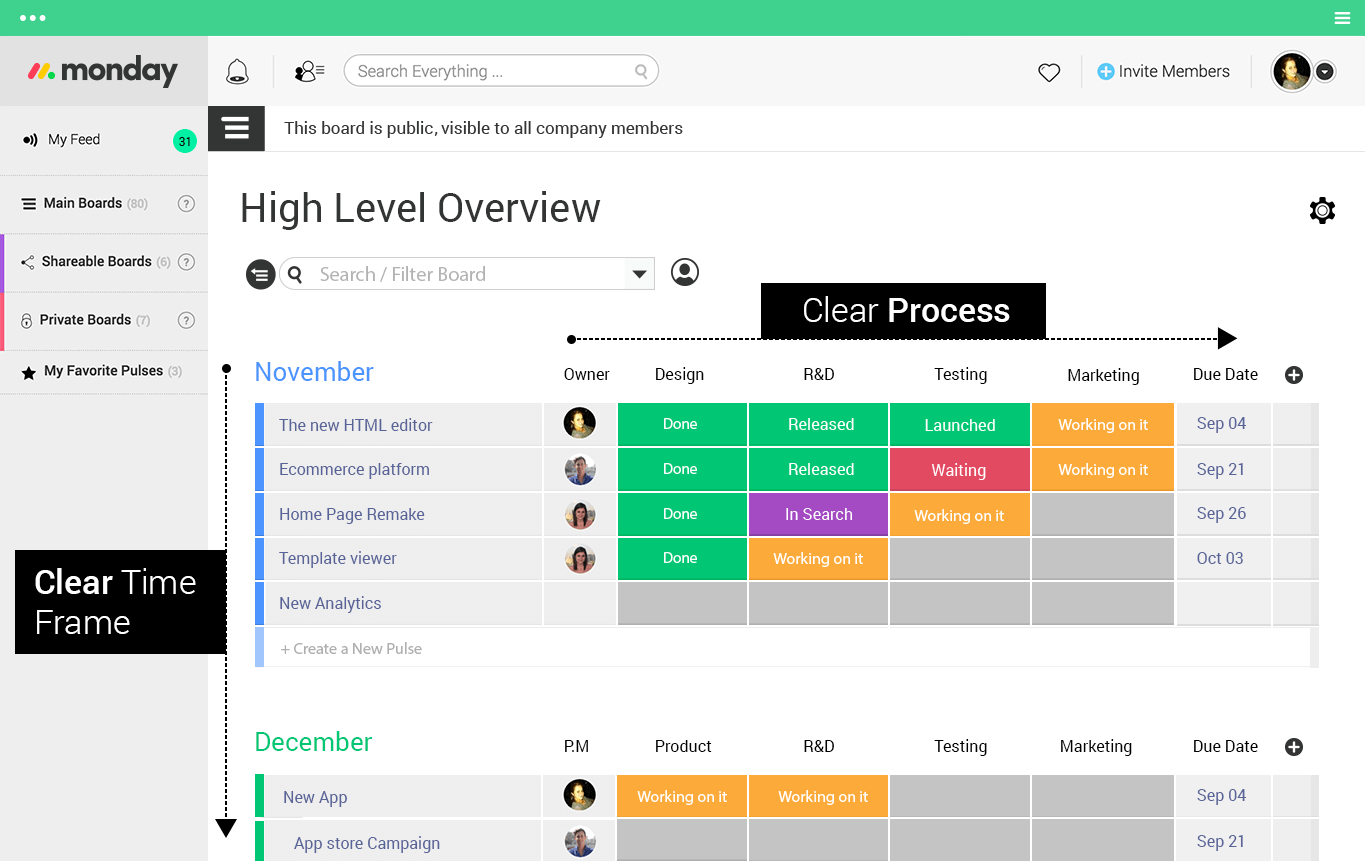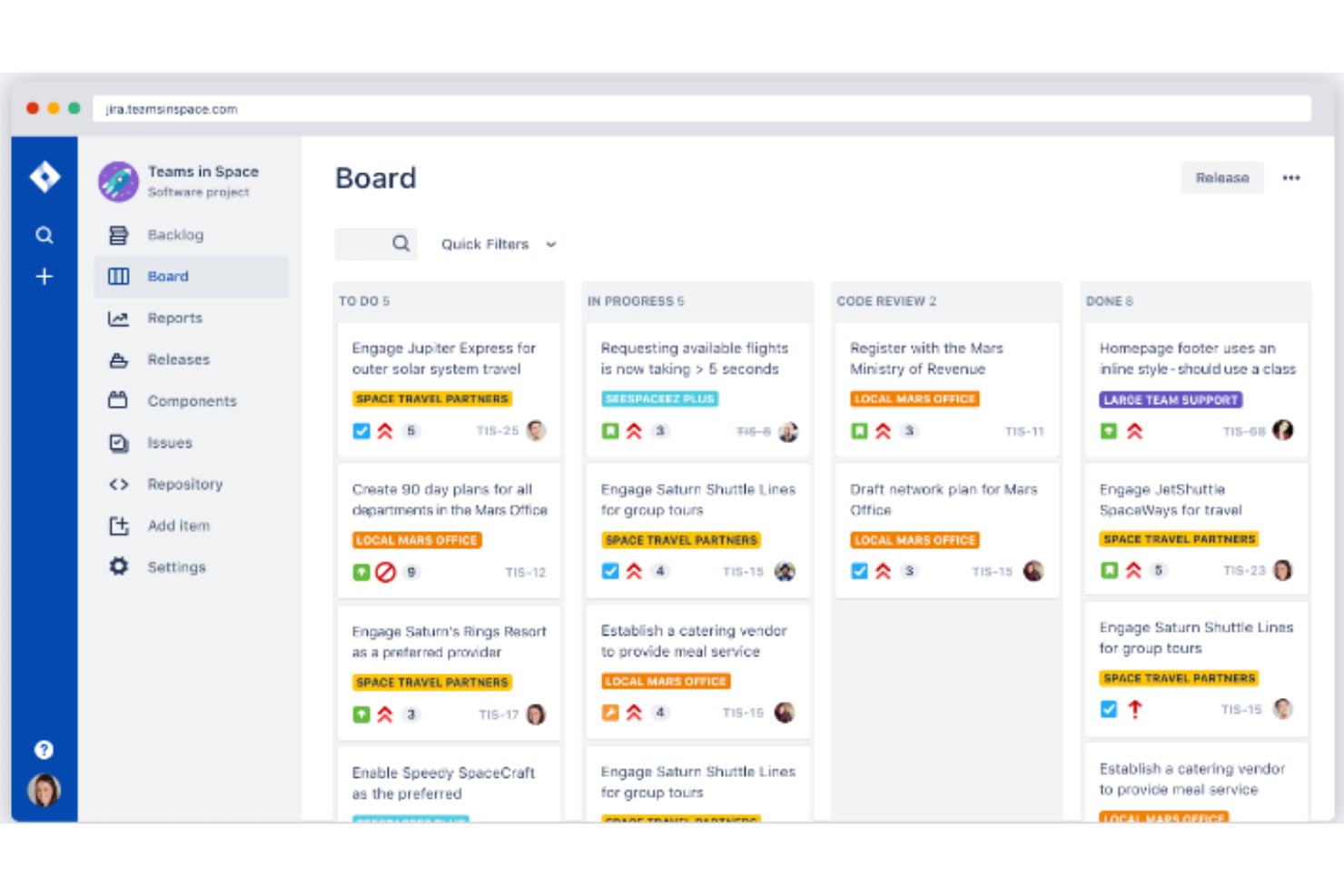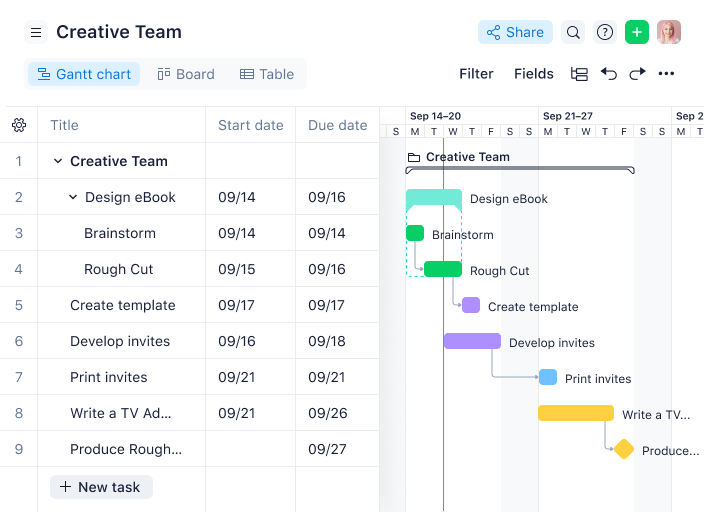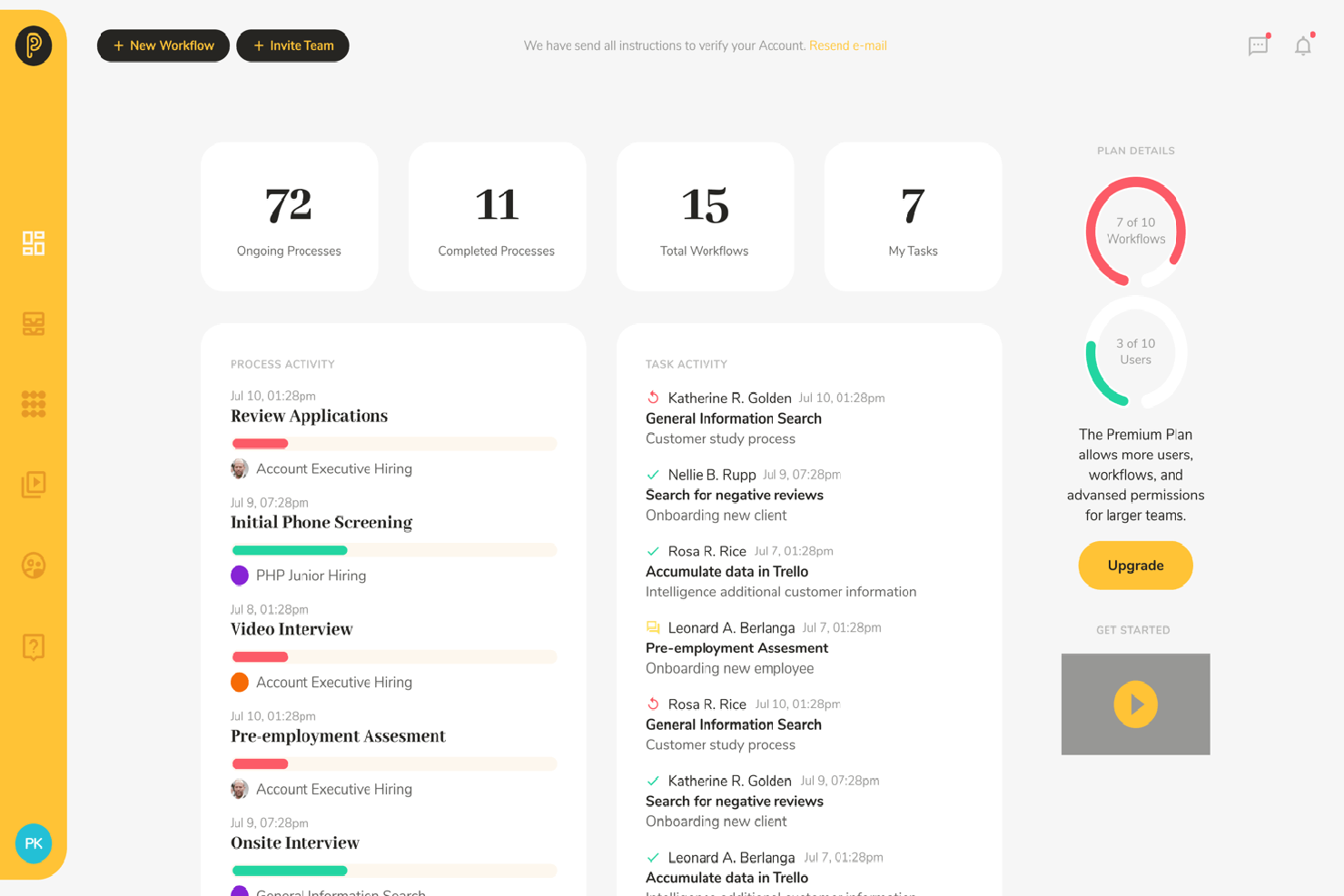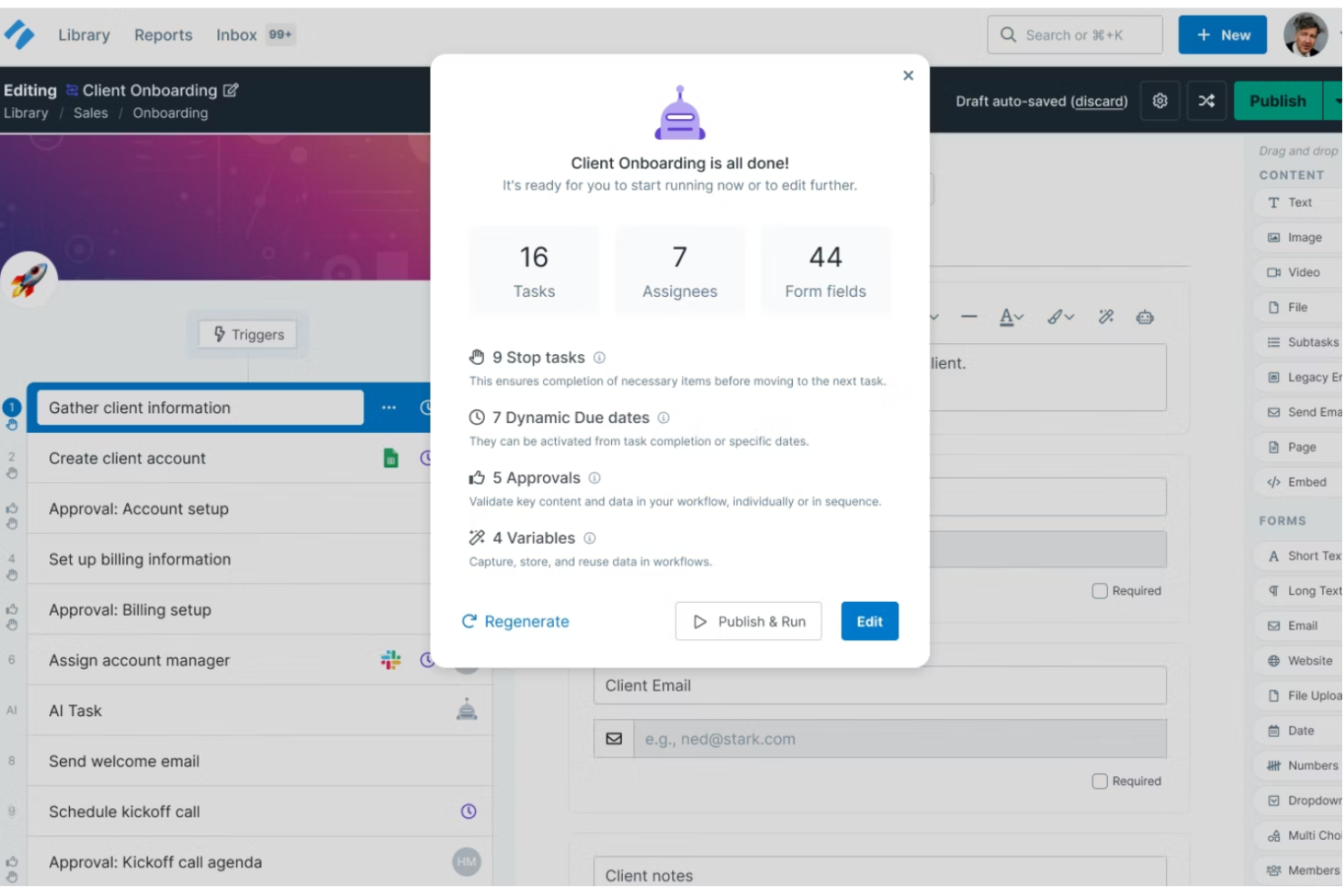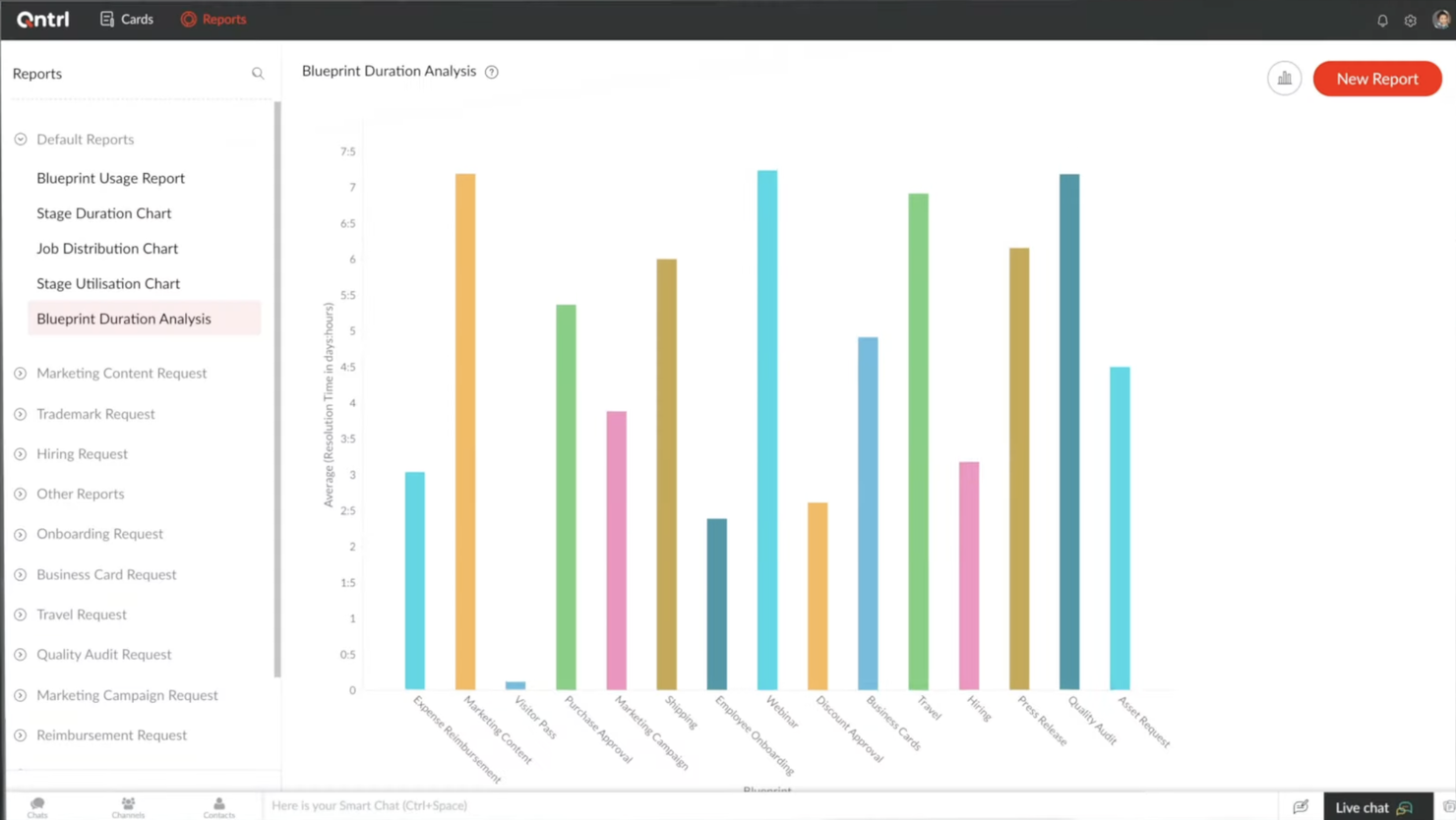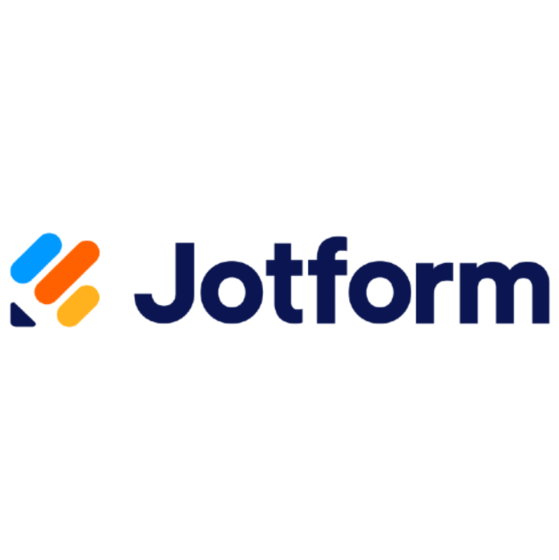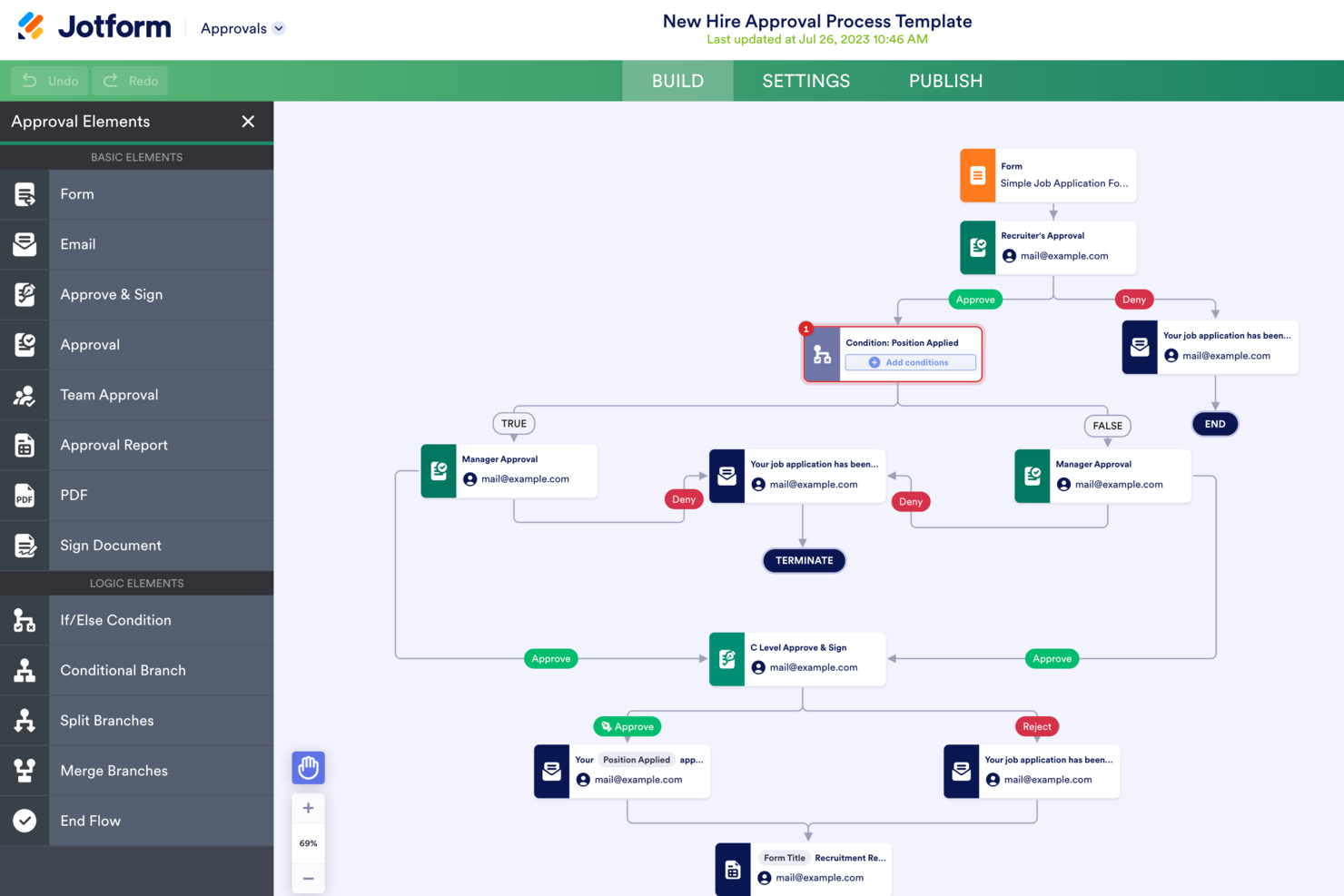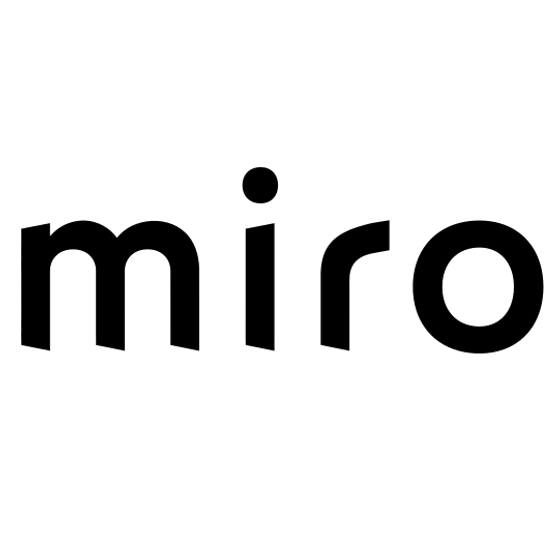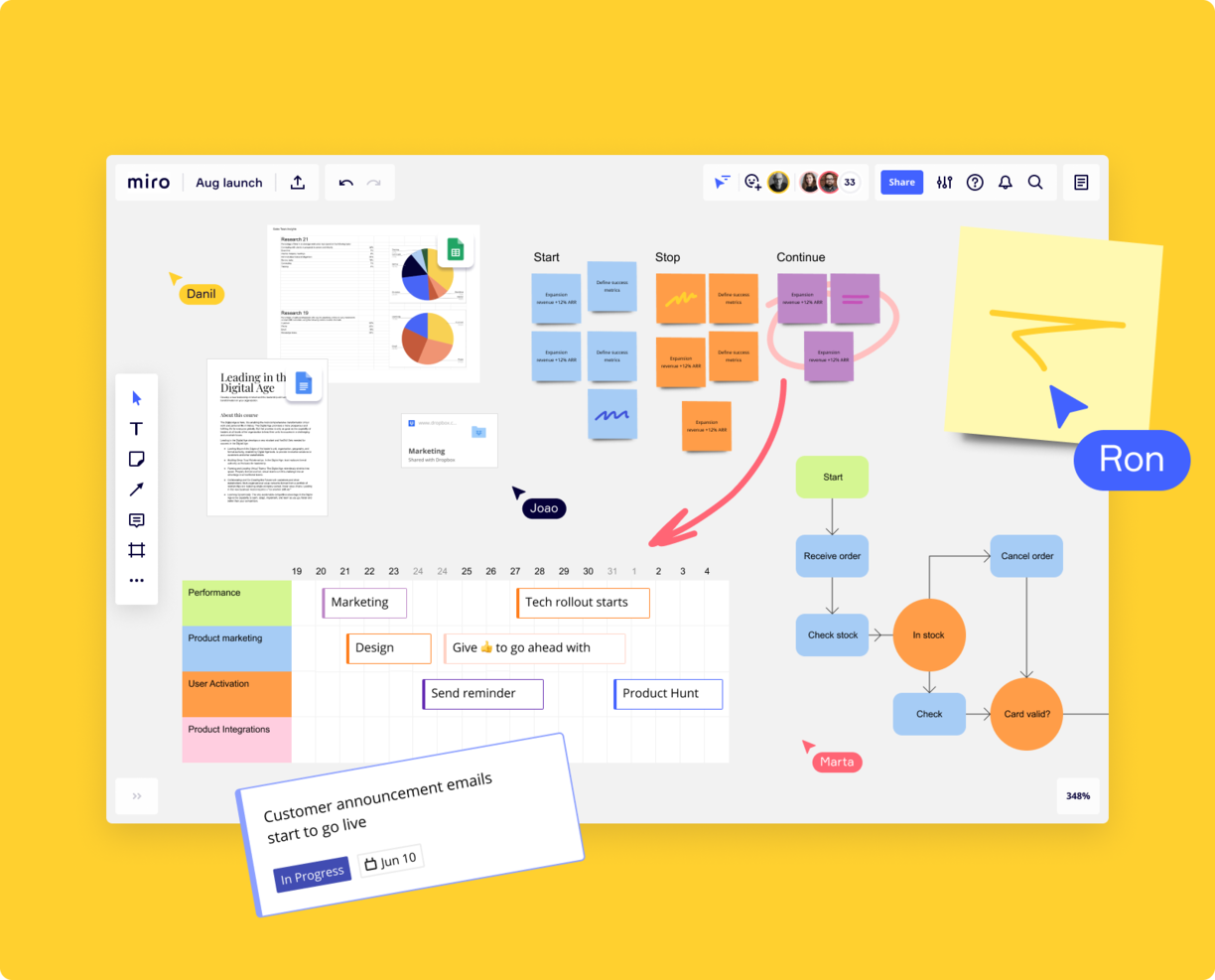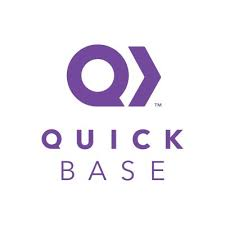10 Die beste Workflow-Management-Software
Here's my pick of the 10 best software from the 20 tools reviewed.
Ein solides Workflow-Management-Tool dient als Leitfaden für den aktuellen Stand der Projektaufgaben, die im Laufe des Projekts durchgeführt werden müssen. Die Projektergebnisse werden dabei in ihrer Gesamtheit durch verschiedene Prozesse, Kontrollen und Bilanzen geformt.
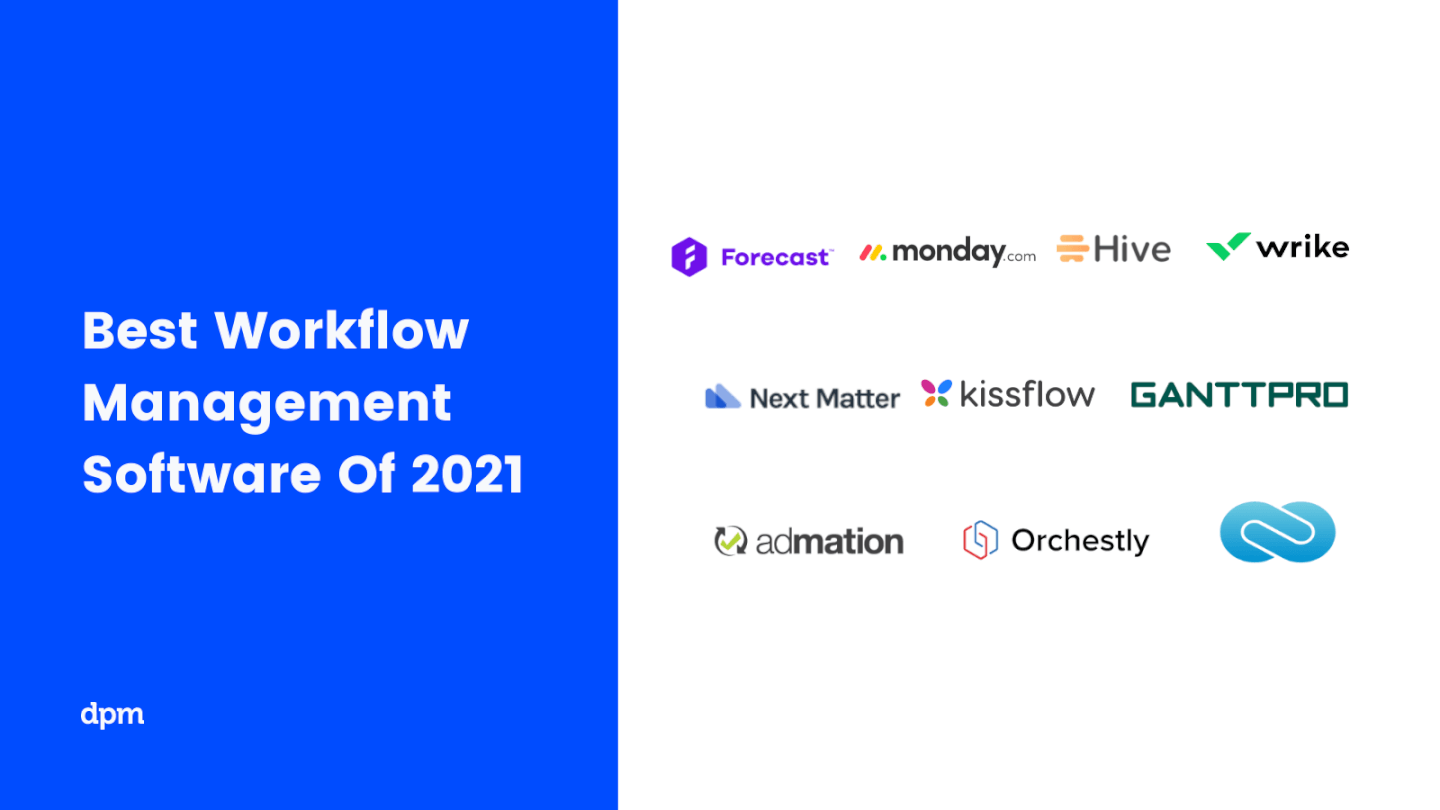
Die Workflow-Management-System fügt deinem Workflow eine Struktur- und Transparenzebene hinzu. So kannst du Ideen in Produkte und Konzepte in Prozesse umsetzen. Diese Tools helfen dir, sicherzustellen, dass das Projekt ordnungsgemäß durchgeführt wird und die Qualität des Projekts erhalten bleibt. Sie unterstützen dich bei der Planung von Aufgaben, der Zusammenarbeit mit anderen, der Verwaltung von Workloads, der Erstellung und Freigabe von Dokumentationen und der Auswertung von Fortschritten. Heutzutage ist die Workflow-Management-Software ein Muss, um Teams zusammenzuhalten, insbesondere angesichts der wachsenden Komplexität und Schnelligkeit unserer zahlreichen, verteilten Mitarbeiter.
Mit den neuen Möglichkeiten der Automatisierung und der Verfügbarkeit nützlicher Daten für die Entscheidungsfindung lassen sich so viel bessere Ergebnisse erzielen als mit einer To-Do-Liste. So kannst du dein Team mit einem umfassenden Ökosystem von Business Process Management Tools (BPM-Tools) unterstützen, um effiziente, optimierte Arbeitsabläufe zu schaffen.
Der Trick dabei ist, zu wissen, wie du die beste Workflow-Management-Systeme für dein Team, deine Geschäftsziele und dein Budget auswählen solltest. Hier ist eine Zusammenstellung der besten Workflow-Management-Software zusammen mit den wichtigsten Kriterien, die bei der Auswahl eines Workflow-Tools zu berücksichtigen sind.
Was leistet eine Workflow-Management-System? (Und wie kann sie dir helfen?)
Was ist eine Workflow-System?
Im Grunde genommen ist ein Workflow-Management-System (WMS) eine Zusammenstellung von Funktionen zum Einrichten, Ausführen und Überwachen von Geschäftsaufgaben.
Was tut eine Workflow-System?
Workflow-Management-System hat viele Namen – man könnte sie als BPM-Software oder einfach als Prozessmanagement-Software bezeichnen. Unabhängig davon, wie du sie nennst, bieten alle Workflow-Tools eine Benutzeroberfläche, um deinen Workflow visuell darzustellen und die vielen beweglichen Elemente zu optimieren.
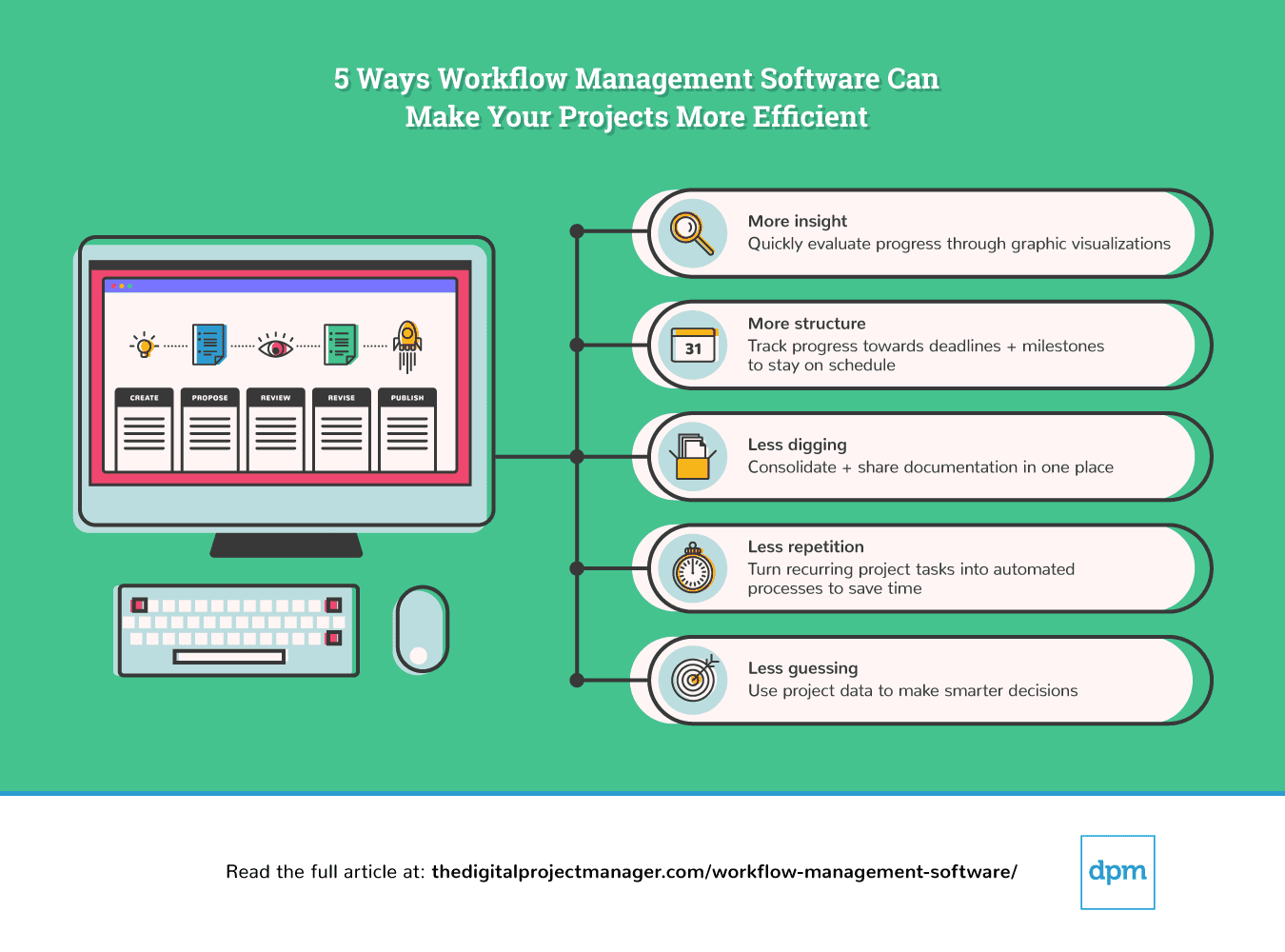 Freelancer, Agenturen, Unternehmen und alle anderen können von einem Workflow-Tool profitieren. Ziel ist es, die Produktivität zu steigern, Kosten zu senken, die Kommunikation zu verbessern und einen reibungslosen Informationsaustausch innerhalb eines Projekts zu ermöglichen. Mit Workflow-Management-Software kann man von der Terminüberwachung auf individueller Ebene bis hin zur Automatisierung wiederkehrender Aufgaben auf Projektebene sowie der Bewertung und Optimierung der Projektleistung auf Geschäftsebene alles tun.
Freelancer, Agenturen, Unternehmen und alle anderen können von einem Workflow-Tool profitieren. Ziel ist es, die Produktivität zu steigern, Kosten zu senken, die Kommunikation zu verbessern und einen reibungslosen Informationsaustausch innerhalb eines Projekts zu ermöglichen. Mit Workflow-Management-Software kann man von der Terminüberwachung auf individueller Ebene bis hin zur Automatisierung wiederkehrender Aufgaben auf Projektebene sowie der Bewertung und Optimierung der Projektleistung auf Geschäftsebene alles tun.
Eine Workflow-Software automatisiert diese Prozesse. Es trägt zu einem BPM-Framework oder -methodik bei.
Was ist ein BPM Framework?
Ein BPM-Framework (Business Process Management) ist ein prozessorientiertes Framework, das die Definition und den Einblick in die koordinierten Aufgaben eines Unternehmens ermöglicht.
Was ist BPM-Methodik?
Die BPM-Methodik zielt darauf ab, die Unternehmensprozesse von Anfang bis Ende zu vereinfachen, um Produktivität und Effizienz zu steigern. Die BPM-Methodik umfasst die Analyse von Geschäftsprozessen, die Erstellung neuer Frameworks und die Überwachung von Prozessen zur kontinuierlichen Optimierung.
The Digital Project Manager ist Mehr zu den Features und Funktionalitäten voner-unterstützt. Wenn du durch die Links auf unserer Website klickst, erhalten wir möglicherweise eine Provision. Mehr Informationen.
Die beste Workflow-Management-Software, um die Effizienz deines Teams zu steigern

At the bottom of the post, we include a table summarizing basic info about the tools described in this article as well as an explanation of our selection criteria, so you can understand how we made this list of workflow management software.
Die beste Workflow-Management-Software zur Steigerung der Effizienz Ihres Teams
monday.com is a project management software used across diverse industries, rapidly growing teams, and enterprise organizations. monday.com sits at the intersection of project management and workflow management software. It simplifies complex workflow processes by streamlining management to focus on structure and transparency.
Why I picked monday.com: you can create tasks on a board and then add the steps required to reach task completion. monday.com is highly customizable and easy to use right out of the box. I also find that it’s incredibly easy to import data from other workflow management software, and even spreadsheets!
Its workflow management software also offers various workflow views that can be arranged by list, geographical map, kanban board, or Gantt chart. These workflows can then be visualized in dashboards to create a bird’s-eye view of the progress and data workflow managers need to monitor. I find information especially useful for workflow managers that sit between their teams and the executive suite and need to communicate complex data sets through visual dashboards.
monday.com Standout Features & Integrations
Features include workflow templates inside of their workflow operating system (Work OS), with workflow automation, data visualization, robust workflow customization for task boards, managing task status, assignees, due dates, hours spent, and more.
Integrations through Zapier include Slack, Google Drive, Gmail, Google Calendar, Jira, GitHub, Trello, Dropbox, Typeform, and others.
Pros and cons
Pros:
- Out-of-the-box workflow automation recipes
- Lots of integrations to support 3rd party data
- Work OS—A specifically designed workflow system for custom workflow apps
- Large workflow template library to jumpstart planning
Cons:
- Minimal multi-lang support
- Limited export functionality for reports
- Initial customization takes time
Jira Software is a project management tool that provides a platform for agile planning and creating customizable workflows. It is designed to improve project transparency and collaboration among team members, and it is scalable to accommodate the needs of both small teams and large enterprises across various industries.
Why I picked Jira Software: Jira Software offers a flexible workflow engine that allows the creation of distinct workflows to match the specific needs of different projects or teams. Users can define their own workflow statuses, transitions, and assignees, and automate tasks to follow the progression of issues from creation to completion. Jira's workflows can also enforce certain criteria before issues move to the next stage, ensuring that all necessary steps are completed.
Jira also supports agile methodologies and provides a platform for teams to create user stories, estimate their work in story points, and prioritize tasks in a backlog. It additionally provides a variety of reports (such as velocity charts, burnup and burndown charts, and sprint reports) that help teams track their agile metrics and make data-driven decisions.
Jira Software Features & Integrations
Features include Scrum and Kanban boards, features to create, manage, and visualize project roadmaps, project, bug, and issue tracking, advanced search with Jira Query Language, and a mobile app.
Integrations include AdobeXD, Invision, Figma, Jenkins, GitHub, Trello, Slack, Confluence, Microsoft Teams, and Google Sheets.
Pros and cons
Pros:
- Organizes tickets in sprints and releases
- Efficient collaboration features
- Helps teams manage multiple projects simultaneously
Cons:
- Requires a learning curve for new users
- Limited error notifications
Wrike is an intuitive workflow management software suitable for teams of five or more, and offers an unlimited number of users. The software enables mangers to customize workflows, dashboards, reports, and request forms.
Why I picked Wrike: The software’s interface enables users to visualize priorities as Kanban boards, interactive Gantt charts, and traditional workload views. Wrike also features automation such as custom request forms that auto-assign tasks, push notifications, and deadline tracking.
Managers can access insightful data through KPI reports, resource management and allocation, and more. The workflow management software also offers a variety of different solutions depending on the type of team or organization, including marketing teams and professional service teams.
Wrike Standout Features & Integrations
Features include personalized app experience via AI Work Intelligence, user and team workload management functionality, account-wide work schedules, shareable dashboards, interactive workflow views, and more.
Integrations are offered natively for over 400 popular platforms including Microsoft, Google, Dropbox, Salesforce, and Marketo.
Pros and cons
Pros:
- Comprehensive workflow modeling
- Individuals and teams can track workloads
- Easily visualize workflow performance
- In-app chat to reduce switch cost for collaboration
Cons:
- Not suitable for small organizations
- High learning curve to fully utilize
- Limited to 10 workflows per space
Pneumatic Workflow is a workflow management solution that helps teams identify, organize, and coordinate sets of tasks in your organization for one fixed price. You can use it to streamline your organization’s processes into workflows with automatic task assignments.
Why I picked Pneumatic Workflow: Their software helps teams effectively minimize routine errors, improve communication between teams, boost productivity, eliminate redundancy, and automate task management. Their workflows can be launched in four ways, namely running the workflow manually, sharing kick-off forms, using external SaaS systems, and using the Pneumatic public API.
Using Pneumatic Workflow, you can build assembly lines to pass the results of certain tasks along to the next team member quickly and efficiently. You can also select pre-built workflows from their free template library, or run unlimited workflows from one template. Their free template library includes all the popular workflows you'd expect, including employee onboarding, content development, purchase approval, customer retention, feature release, and more.
Pneumatic Workflow Standout Features & Integrations
Features include a workflow template builder, workflow variables & tools, a tasks interface, highlights, shareable kick-off forms, automations, activity highlights, urgent prioritization, video-based workflows, informative data dashboards, comments and mentions, and a WYSIWYG editor.
Integrations are available by connecting a paid Zapier account and you can build custom integration using its API.
Pros and cons
Pros:
- Their freemium plan includes enough features to get small teams started
- You can easily collaborate with guest (external) project stakeholders
- They offer a 30-day money back guarantee if you are unsatisfied with their platform
Cons:
- Not many built-in software integrations
- Limited chat support window (9 am to 5 pm CST)
Process Street is a process-driven tool that adapts well to simple workflow strategies. While Process Street doesn’t offer as much as other workflow management software tools in terms of analytics and reporting, it’s a good fit for teams with document-driven workflows. The free plan welcomes an unlimited number of users, which is a nice trade-off for being feature lite in some areas.
Process Street’s approach breaks up workflow management into three chunks: handling documentation (creating, exporting, and embedding procedure documents and templates), running trigger-based workflows (for random events initiated by a trigger, such as a client onboarding), and programming scheduled tasks that run on an automated schedule. Its drag-and-drop task manager makes it easy for anyone to use.
Why I picked Process Street: With many tools for process documentation and workflow automation, it’s a good choice for teams who want a streamlined process framework without a maze of features to get lost in.
Process Street Standout Features & Integrations
Features include workflow management, task scheduling/tracking, attendance tracking, data visualization, employee database, vacation & absence calendar, process reporting, status notifications, employee incentive management, and process modeling.
Integrations include 1000+ apps through Zapier. It also integrates with Formstack, opening up a world of additional templates.
Pros and cons
Pros:
- Checklists utilize conditional logic
- Automation for onboarding/training
- Unlimited workflow checklists and templates
- Great third-party integration options
Cons:
- No drag-and-drop for checklist reordering
- Missing field validation for phone numbers (emails only)
Formerly Orchestly, Qntrl is a low-code workflow orchestration software that brings visibility, control, and automation to processes by cutting down on manual work. The platform lets users control all incoming requests for a team through a centralized interface.
What users love: Qntrl comes with integrated tools to help workflow process managers design, deploy, and iterate workflows for almost any process. Workflow managers can leverage process automation mapping experience assists in creating custom forms to quickly fetch essential data. Users can escalate issues, assign tasks, approve/reject stages, and handle huge data transfers from spreadsheets present in different verticals.
Qntrl Standout Features & Integrations
Features include robust data management and visualization, workflow-centric collaboration functionality, process mapping, real-time workflow and task status updates, low-code automation, and more.
Integrations include other Zoho products and outside applications and third-party apps through built-in APIs.
Qntrl is completely free for companies with a maximum of 5 users.
Pros and cons
Pros:
- Modest per-user price
- Native integration with Zoho
- Great workflow visualizations (“Blueprints”)
- Webhooks can send notifications to third-party applications
Cons:
- Field names have to be unique across flows
- Complex feature set has a learning curve
Jotform Enterprise is a a powerful, easy-to-use data collection process for businesses of all kinds who are looking to optimize their workflow management processes. With Jotform, businesses will have access to offline forms, surveys for product feedback and reviews, collaboration tools, approvals for automated workflows, and conditional logic for a personalized customer form experience. They specialize in B2B businesses but can be adapted to a wide range of customer markets and industries.
Why I Picked Jotform Enterprise: Jotform Enterprise offers companies an easy-to-use tool that makes closing deals, collaborating with coworkers, signing waivers, and collecting form responses a more seamless process. Jotform Enterprise provides you with a wide range of workflows, forms, reports, and automation tools that can be used to build custom applications tailored to your needs. It also allows you to create customized forms for collecting data from customers or employees and then create automated workflows based on this data.
Jotform workflows can automate everyday tasks such as customer onboarding, order processing, invoicing, approvals, reminders, notifications, and follow-ups, allowing businesses to save time by eliminating manual processes.You can set up automated form submissions so that all incoming data is automatically sent to the designated destination, like your customer database or email account.
Additional features include workflow automations, conditional logic, e-sign documents with automated signing orders, webhooks, API, and helpful ways to integrate feedback into your workflow.
Jotform Enterprise Standout Features & Integrations
Features include form building tools, mobile responsiveness, payment integration, conditional logic, data collection and management, form branding, multi-language support, SSL encryption, and integration with third-party apps.
Integrations include Google Drive, Google Sheets, Slack, Dropbox, PayPal, Stripe, Salesforce, Mailchimp, and Airtable. It also can integrate with Zapier to automate workflows and connect JotForm with over 1,000 other apps and services but this requires a Zapier account and may incur additional costs.
Pros and cons
Pros:
- Wide range of workflow templates
- Mobile-responsive forms & surveys
- Cost-effective, even for Enterprise plans
Cons:
- Required Zapier for most integrations
- Data visualization options are limited
Miro is a collaborative online whiteboard with over 1,000 templates including mind maps, Kanban boards, Gantt charts, product wireframes, research boards, and flowcharts. It’s trusted by 99% of the Fortune 100, and used by teams at TransUnion, HP, Upwork, Cisco, Qlik, and Atkins. Miro’s visual platform is built for hybrid work, and has robust resources for continuous learning like Miro Academy, online events, and a community forum.
One of Miro’s many functionalities is as a workflow management tool with a focus on interactive, visual work boards. Visualize, chart, and share workflows with your team with ease — and watch your project go from idea to execution all in one place.
At The Digital Project Manager, we use Miro to map out content clusters and to visualize content workflows from start (brainstorming ideas) to finish (publishing the content on our site).
Miro has integrations with a whole suite of tools, including Zoom, Figma, Asana, Microsoft Teams, Jira, Slack, Google Drive, Box, Airtable, Notion, Azure, and Webex. Some integrations are limited to paid plans only.
Miro is free to use for unlimited members with up to 3 editable boards. Paid plans start at $8/user/month (billed annually).
Pros and cons
Pros:
- Free forever plan available
- Intuitive and easy setup
- Built-in communication features for streamlined collaboration
Cons:
- Visitor/guest accounts locked to paid plans only
- Zooming can be jumpy on larger projects
- Free version does not allow high-quality export to pdf
QuickBase offers a platform designed for dynamic work management, providing a robust solution for businesses to manage complex projects and processes. It distinguishes itself as a leading choice for dynamic work management by offering a no-code application platform that empowers teams to create, connect, and control their workflows with ease and efficiency.
Why I picked QuickBase: I chose QuickBase for workflow management because it offers a highly customizable platform that caters to a variety of project types and industries, including construction, manufacturing, property management, education, government, and legal. You can use their software to set up workflows for numerous business needs, including project management, process improvements, field services, supply chain monitoring, training, and customer relations.
What sets QuickBase apart is its emphasis on enabling users to create, connect, and customize applications without the need to replace existing systems. This flexibility is particularly valuable for dynamic work environments where adaptability is key.
QuickBase Standout Features & Integrations
Features include project management, resource management and scheduling, budget and financial management, portfolio management, subcontractor management, contract management, and work order management.
Integrations include Salesforce, Slack, Microsoft Teams, Google Calendar, Gmail, Outlook, Dropbox, and Box. QuickBase also supports industry-specific integrations and custom connections through RESTful APIs.
Pros and cons
Pros:
- Robust notifications and reminders
- Simple no-code platform is easy for non-tech people to learn
- Workflows are easy to set up and customize
Cons:
- Project management integrations are limited
- Team plan requires a minimum of 20 users
Kissflow Workflow is a workflow management software with automation features and a no-code interface.
Why I picked Kissflow Workflow: Users can build out their existing workflows in the software, or select from the large bank of templates available in the platform. Ready to use templates for sales teams, HR departments, as well as procurement, finance, and operations processes are available to get business processes up and running. Users can collect and store data with the drag-and-drop form builder, and stay up to date on workflow progress with automated notifcations.
Kissflow Workflow Standout Features & Integrations
Features include workflow templates, WYSIWYG form builder, predefined steps (linear and branched), stakeholders, conditions, pre-built reports, automatic task assignment, and a mobile app.
Integrations include the Google Workspace suite, and additional integrations can be configured using the software's API.
Pros and cons
Pros:
- Part of the larger Kissflow ecosystem (project management and app builder)
- No coding knowledge needed to build workflows
- Friendly and intuitive user interface
Cons:
- Migration from other tools can be cumbersome
- Limited reporting and analytics
Zusammenfassung der besten Workflow-Management-Software
Hier findest du eine Tabelle mit grundlegenden Informationen zu den in diesem Artikel beschriebenen Tools. Informiere dich über die Preise und die Verfügbarkeit kostenloser Tests, um einen schnellen direkten Vergleich durchzuführen.
| Tools | Price | |
|---|---|---|
| monday.com | From $8/user/month (billed annually, min 3 seats) | Website |
| Jira Software | $10/user/month | Website |
| Wrike | From $9.80/user/month | Website |
| Pneumatic Workflow | From $99/month (unlimited users) | Website |
| Process Street | From $25/user/month (billed annually), Process Street offers a Business plan that includes features such as unlimited checklists, templates, and reporting, as well as access to their library of pre-made process templates. There is also a free plan available with limited features, and custom enterprise solutions can be discussed with their sales team. | Website |
| Qntrl | $8/user/month | Website |
| Jotform | From $39/user/month | Website |
| Miro | From $10/user/month | Website |
| QuickBase | From $600/month (billed annually), which equates to $25/user/month with a minimum requirement of 20 users. This is for the Team plan, which includes core features suitable for smaller teams. For larger organizations or those needing advanced features, QuickBase offers higher-tier plans, and pricing for these can be obtained upon request. | Website |
| Kissflow Workflow | From $15/user/monthly | Website |

Compare Software Specs Side by Side
Use our comparison chart to review and evaluate software specs side-by-side.
Compare SoftwareWeitere Workflow-Management-Software, die es wert ist, in Betracht gezogen zu werden
Ich hatte noch keine Gelegenheit, diese richtig zu analysieren, aber wenn die in der Review enthaltenen Tools nichts für dich sind, solltest du dir diese zusätzlichen BPM-Tools ansehen:
- beSlick
Best to identify and improve work processes
- SysAid
Best for internal service departments
- Hive
Best small business workflow management software
- Kissflow
Best enterprise workflow management software
- Quixy
Best no-code workflow management software
- Pipefy
Best to build shareable forms, portals, and actions
- Forecast
Best for managing your projects, resources, and finances in one
- Cflow
Best workflow management software for growing organizations
- DocuWare
Best for document management & e-signatures
- Avaza
Best iPhone, iPad, and Android friendly workflow app
Möchtest du die Optionen eingrenzen?
Dieses Tool ist ziemlich nützlich. In Zusammenarbeit mit Crozdesk haben wir uns bemüht, dir Zugang zu dem “Software-Finder” zu geben.
Wenn du einige der Details über dein Projekt und die Funktionen, die du in einem Projektmanagement-Tool suchst, eingibst, wird eine Liste von Tools erstellt, die deinen Präferenzen entsprechen. Du gibst deine E-Mail an das Team weiter und es schickt dir einen nützlichen PDF-Leitfaden mit einer Zusammenfassung deiner besten Übereinstimmungen.
Wie wählt man die beste Workflow-Management-Software aus?
Wofür brauchst du es?
Wenn du dich danach fragst, versuchst du eigentlich zu identifizieren: sind meine Prozesse menschlich oder systemzentriert? Ein menschenorientierter Workflow konzentriert sich mehr darauf, Menschen und ihre Aufgaben, Dokumente und Fortschritte an einen Ort zu bringen. Ein systemzentrierter Workflow konzentriert sich darauf, verschiedene Geschäftsprozesse oder Systeme zusammenzuführen und deren Funktionen zu einem einheitlichen Workflow auf einem zentralen Punkt zu integrieren.
Wer wird es benutzen?
Wie viele Personen sind in deinem Team? Wer wird das Tool einsetzen und benötigst du eine rollenbasierte Zugriffskontrolle? Du solltest dich auch fragen, welche Arten von Personen das Tool verwenden werden, um zu entscheiden, ob du etwas Codebasiertes oder mit Low/No-Code benötigst.
Wenn man an sein Team denkt, ist es leicht anzunehmen, dass ein großes Team zwangsläufig komplexere Workflow-Funktionen benötigt. Dabei sollte man jedoch bedenken, dass selbst große Projekte am besten mit einfachen Workflows funktionieren und dass alles, was wirklich notwendig ist, die Möglichkeit ist, Aufgaben zuzuweisen, Dokumente gemeinsam zu nutzen und Termine zu verfolgen. Auf der anderen Seite können selbst sehr kleine Teams komplexe Workflows haben, die von erweiterten Berichts-, Ressourcenmanagement- und Optimierungsfunktionen profitieren.
Wie würde das in deinen Prozess passen?
Passt dieses Tool zu deinem bestehenden Toolkit und lässt sich mit den richtigen Tools integrieren? Wenn dies eines der ersten Tools ist, die du hinzufügst, kann es dann skaliert und erweitert werden, um deine Bedürfnisse zu erfüllen, wenn dein Unternehmen wächst? Frag dich selbst, ob dein Team es online nutzen wird, oder ob es etwas braucht, das auch offline funktioniert.
Wie lange dauert es, bis es reibungslos läuft?
Ist es einfach zu implementieren? Schau dir außerdem die Einfachheit des Onboardings an: Ist es ein Tool, das dein Team leicht erlernen kann? Viele Tools bieten je nach Preisstufe unterschiedliche Support-Level – bietet es technischen Support, oder wirst du hängen gelassen? Und schließlich, wird die Software gehostet, oder wirst du die Infrastruktur dahinter unterhalten?
Wie viel kostet es?
Die Preise liegen in einem weiten Bereich von $0-$40 pro Benutzer und Monat. Die meisten Workflow-Tools werden pro Benutzer berechnet, was die Wichtigkeit unterstreicht, zu berücksichtigen, wie viele Teammitglieder es verwenden werden. Außerdem ist zu berücksichtigen, wie viele Teammitglieder es in Zukunft verwenden werden. Achte darauf, dass du überprüfst, wie die Kosten mit deiner Skalierung steigen werden. Nicht nur, dass deine Kosten mit jedem Teammitglied steigen werden, du musst auch deinen Plan auf eine kostspieligere Stufe aufstocken, wenn deine geschäftlichen Anforderungen steigen.
Was denkst du dazu?
Was berücksichtigst du bei der Wahl einer Workflow-Management-System? Welche Erfahrungen hast du mit der Auswahl und dem Einsatz von Workflow-Software gemacht? Erzähle unserer Community, was deiner Meinung nach die wichtigsten Aspekte bei der Auswahl eines Workflow-Tools sind.




